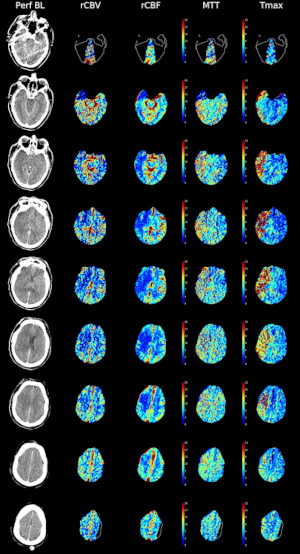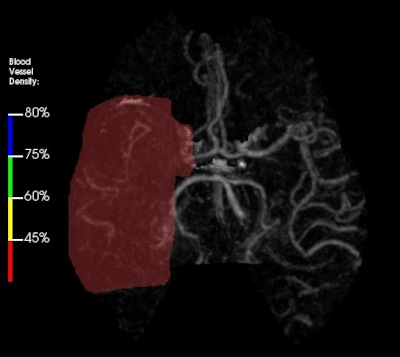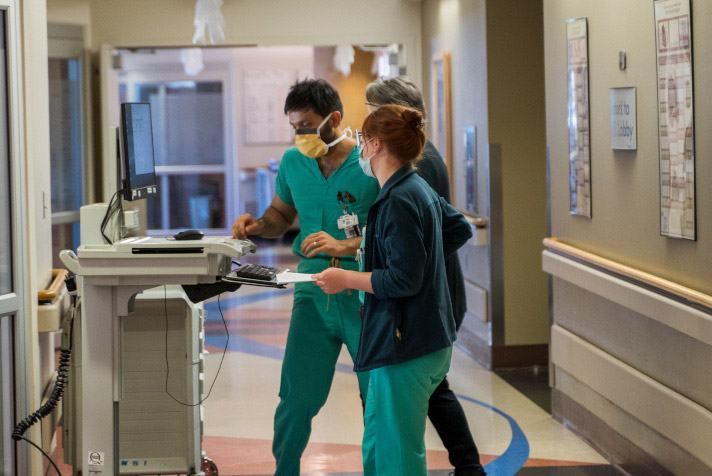Imagine you are at work and a young colleague suddenly has a facial drooping, trouble speaking or problems with their balance. What would you do?
Chances are, your first thought wouldn’t be a stroke. Isn’t that an older person’s problem? Unfortunately, stroke can happen to anyone of any age—and rates of stroke in patients under age 50 are on the rise.
According to the American Heart Association, incidents of stroke have increased 40% among young U.S. adults over the past several decades. Approximately 10-15% of strokes occur in adults age 18-50.
Many things have led to an increase in young adult strokes. Not only are people 50 and younger subject to typical risk factors—high blood pressure, blood clots, diabetes—they also face unique risks specific to lifestyle, pregnancy and genetics.
As New Mexico’s first and only Comprehensive Stroke Center and academic medical center, UNM Hospital provides neurocritical care for the most complex and unusual cases—including young patients whose stroke care was delayed, resulting in a battle to reclaim their previous quality of life.
Let’s discuss what causes strokes in young adults and how to spot the symptoms. This information could save a life!
What Causes Strokes in Young People?
 Hypertension, high cholesterol, diabetes, smoking and obesity are the major risk factors for stroke. According to the Centers for Disease Control and Prevention, about one-third of U.S. adults has at least one of these problems.
Hypertension, high cholesterol, diabetes, smoking and obesity are the major risk factors for stroke. According to the Centers for Disease Control and Prevention, about one-third of U.S. adults has at least one of these problems.
Other health factors that can increase stroke risk in younger patients include:
- Binge drinking.
- Birth control pills that include estrogen.
- Blood clotting disorders.
- Cocaine or other drug use.
- Migraine with aura, which is associated with increased risk of having an ischemic stroke. Women have more migraines and are more at risk, particularly if they also smoke or take estrogen-containing birth control pills.
- Patent foramen ovale, a hole in the heart that never closes after birth, which affects approximately 25% of patients.
- Pregnancy and the postpartum period.
- Sedentary lifestyle.
- Sickle cell disease – nearly a quarter of patients with this condition have a stroke by age 45.
The prevalence of stroke risk factors has increased in Native Americans over the last two years especially hypertension and smoking.
What are the Symptoms of Stroke?
Generally, ischemic (related to a blood clot) and hemorrhagic (related to bleeding in the brain) strokes symptoms are similar in younger and older adults. Think of the acronym BE FAST:
- Balance
- Eyesight changes
- Facial drooping
- Arm weakness, especially on just one side
- Speech difficulty
- Time to call 911!
Young patients may also experience symptoms that could easily be shrugged off as something else, including:
- Sudden numbness in their hands
- Confusion or trouble thinking clearly
- Problems walking
- Severe headache
Women may experience other seemingly unrelated signs of stroke, such as difficulty breathing, general weakness, fainting, hallucinations or nausea and vomiting.
Stroke may strike seemingly out of nowhere. But approximately 12% of patients have a “warning stroke” known as a transient ischemic attack (TIA) or “mini-stroke” up to 90 days of a full-blown stroke. TIA may cause symptoms similar to an intense migraine when a clot temporarily blocks a blood vessel but gets dislodged.
Providers, patients and bystanders must never ignore suspected stroke symptoms. The faster a patient can be diagnosed and treated, the more of their brain and physical body we can potentially save.
Where Patients Get Stroke Care Matters
Every patient with a suspected stroke should be transferred immediately from a community hospital to either a Primary Stroke Center or Comprehensive Stroke Center, depending on the severity of their symptoms.
Young patients and those with complex stroke symptoms should automatically go to a Comprehensive Stroke Center such as UNM Hospital. Comprehensive centers have neurocritical intensive care units that are staffed 24/7 by specialists in stroke treatment, high-risk pregnancy and complications such as brain bleeding and swelling.
Every young patient with suspected stroke at UNM Hospital gets a thorough brain and heart exam, including blood work and imaging. We do this to rule out non-stroke conditions, such as heart attack, autoimmune disease or substance use problems.
Once we know a patient is having a stroke, we must find out whether the stroke is ischemic or hemorrhagic. More than 80% of strokes are ischemic.
Treatment for Types of Stroke
 Intravenous tissue plasminogen activator (TPA): For best results, we must administer clot-busting TPA medication within 4.5 hours of when symptoms begin. The sooner the patient arrives, the better we can stop the stroke and reduce disabling side effects.
Intravenous tissue plasminogen activator (TPA): For best results, we must administer clot-busting TPA medication within 4.5 hours of when symptoms begin. The sooner the patient arrives, the better we can stop the stroke and reduce disabling side effects.
Thrombectomy: A patient with a big clot blocking a blood vessel in their brain may be eligible for this procedure to remove the clot. We can find the clot under imaging and use a special tool to collect and remove the clot from the brain. Patients who get thrombectomy within 8 hours of a stroke tend to have better outcomes.
Bleeding control: With hemorrhagic stroke, stopping the brain bleed is our top priority. Medication can help slow the bleeding. In some cases, patients need emergency surgery to relieve brain swelling or repair or remove a ruptured blood vessel.
After a stroke, patients often need physical, occupational and/or speech therapy—the sooner the better to regain their pre-stroke quality of life. When care is delayed, patients may be left with permanent disabilities.
Patients of any age who have a stroke are at increased risk to have another stroke or a heart attack. These patients need long-term follow-up to reduce the risk of disability or dying young.
Everyone Can Help Save Lives
Fast action is key when it comes to stroke. But to get early help, emergency responders and community providers must recognize stroke symptoms in young patients and know when to go directly to the Comprehensive Stroke Center.
Just as importantly, we must also be able to recognize stroke symptoms in each other. Particularly in New Mexico, there is a pressing need for providers to double down on community education. According to a survey published in Stroke, Hispanic patients are twice as likely as non-Hispanic whites to be unaware of common stroke symptoms.
A decade ago, if a young adult patient had unusual brain or body symptoms, stroke would have been the furthest diagnosis from our minds. Now, it’s tragically common.
We’ve had to adapt the old stroke adage “time is brain.” It no longer applies just to fast action at the first sign of stroke symptoms—it means giving time back to young stroke patients by doing all we can to preserve their cognition and function.
Get Expert Neurology Care
Visit with a neurologist at UNM Comprehensive Stroke Center. Referral may be required. Call 505-272-4866 today.

